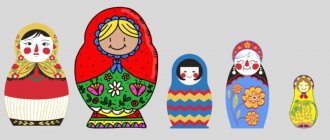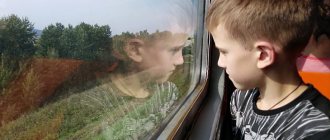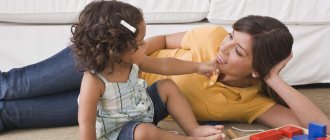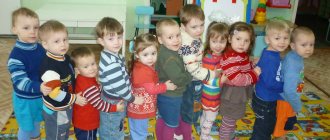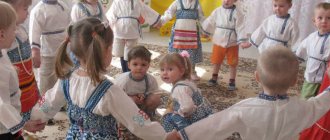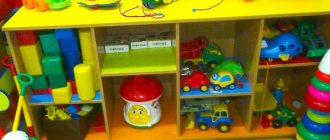Finger gymnastics and its meaning for a child
Research has proven that the development of a child’s speech directly depends on the development of manual motor skills. At a high level, logic, coherent speech, memory and attention are well developed. Moreover, if, upon reaching four years of age, a child cannot bring water to his face in his joined palms, then his manual fine motor skills are lagging behind in development. That’s when parents turn to finger gymnastics for help for their kids.
Finger gymnastics
Methods and goals of finger gymnastics in kindergarten
At the preschool educational institution, classes are conducted on music, physical education, and even walks. The work plan of a general education institution highlights the following goals:
- Development of finger dexterity, imagination and attention.
- Activation of speech centers.
- Creating a positive attitude in the group.
Note! Finger gymnastics in kindergarten is based on the method of influencing the child’s internal organs with the hands.
For example:
- The thumb point is responsible for the functioning of the brain;
- The index finger is responsible for the functioning of the stomach;
- The middle finger controls the integrity of the spine and intestinal tract;
- The liver is associated with the ring finger;
- Heart with little finger.
Additional attraction of the child's attention
What are finger games? Why are finger games needed? article on speech development on the topic
What are finger games?
What are finger games for?
To the famous teacher V.A. Sukhomlinsky owns the saying: “The child’s mind is at the tips of his fingers.” Today, all mothers and fathers, without exception, know that playing with fingers develops the child’s brain, stimulates the development of speech, creativity, and imagination of the baby. Simple movements help to remove tension not only from the hands themselves, but also to relax the muscles of the whole body. They can improve the pronunciation of many sounds. In general, the better the fingers and the entire hand work, the better the child speaks. To determine the level of speech development, speech therapists have long developed the following method: the child is asked to show one finger, two fingers and three. Children who are able to make isolated finger movements are talking children. If the movements are tense, the fingers bend and straighten only together and cannot move separately from each other, then these are children with problems in speech development.
The fact is that the hand has the largest “representation” in the cerebral cortex, therefore the development of the hand plays an important role in the formation of the brain and the formation of speech. And that is why the child’s verbal speech begins when the movements of his fingers achieve sufficient accuracy. The child’s hands, as it were, prepare the ground for the subsequent development of speech. In addition, the goal of classes to develop dexterity and accuracy of the fingers is to develop the relationship between the hemispheres of the brain and the synchronization of their work. The fact is that in the right hemisphere of the brain we have various images of objects and phenomena, and in the left they are verbalized, that is, they find verbal expression, and this process occurs thanks to the “bridge” between the right and left hemispheres. The stronger this bridge, the faster and more often nerve impulses travel along it, the more active the thought processes, more precisely the attention, the higher the abilities.
If you want your child to speak well, learn quickly and easily, and deftly perform even the most delicate work, start developing his hands: fingers and hands from an early age.
In China, exercises with stone and metal balls are common. Regular exercises with them improve memory, the functioning of the cardiovascular and digestive systems, eliminate emotional stress, develop coordination of movements, strength and dexterity of the hands, and maintain vitality. And in Japan, exercises for palms and fingers with walnuts are widely used. Rolling a hexagonal pencil between your palms has an excellent effect.
Finger games have been common among a variety of peoples for a long time. So, from an early age, our children were taught to play “Ladushki”, “White-sided Magpie”, “Horned Goat”. Today, experts are reviving old games and inventing new ones.
Finger games for little ones
A newborn's hands are always clenched into fists, and if an adult places his index fingers in the child's palms, he squeezes them tightly. This way you can even lift the baby a little. As the brain matures, this reflex develops into the ability to grasp and release. Attention, parents: the more often the child’s grasping reflex “turns on,” the more effective his emotional development occurs.
You can train your child’s fingers as early as six to seven months by massaging the hands and each finger separately, each of its phalanxes. You should stroke in the direction from the fingertips to the wrists, and each of the child’s fingers is bent and unbent in turn. It is useful to carry out such simple exercises daily for 2-3 minutes.
From the age of 10 months, the development of fine movements of the fingers and the entire hand should begin. Let your baby sort through large objects first, and then smaller ones. A child can roll wooden balls of various diameters, sort through large beads strung with an elastic band, collect pyramids, construct from cubes, transfer pencils and buttons from one pile to another. It is important that all fingers are involved in the movement. Help your little one use his fingers in a coordinated and dexterous way in everyday life. Pay attention to mastering such simple, but at the same time important skills - holding a cup, spoon, pencil, washing your face. And, of course, at this age they are already playing with all their might in “The White-sided Magpie”:
Magpie, magpie, Where were you? - Far! I cooked the porridge and put it on the table. She jumped onto the porch and waited for guests. This is porridge, This is mash, This is raspberries, This is viburnum, And this is a cone, A cone - under the sock! He’s a small boy, He didn’t tear up the krupka, He didn’t walk in the water, We won’t give him any porridge! And little Sashka didn’t get any porridge! Shug-shug! They flew, sat on their heads, and sang songs!
And here is another ending to “The White-sided Magpie”:
Why didn't you chop wood? Know in advance: Didn't carry water? The water here is cold (stroking the child on the wrist). It’s warm here (stroking along the crook of the elbow). It's hot here (patting the shoulder). And here - boiling water, boiling water! (Tickle the child).
The influence of manual (manual) actions on the development of the human brain was known back in the 2nd century BC in China. Experts argued that games involving hands and fingers, such as our “White-sided Magpie,” help to find harmony in the body-mind tandem and keep the brain systems in excellent condition. Based on similar reasoning, the Japanese doctor Namikoshi Tokujiro created a healing technique for influencing the hands. He argued that fingers are endowed with a large number of receptors that send impulses to the human central nervous system. There are many acupuncture points on the hands, by massaging which you can influence the internal organs reflexively associated with them. In terms of saturation of acupuncture zones, the hand is not inferior to the ear and foot. For example, massaging the thumb increases the functional activity of the brain; the index finger has a positive effect on the stomach, the middle finger has a positive effect on the intestines, the ring finger has a positive effect on the liver and kidneys, and the little finger has a positive effect on the heart.
Finger games for older children
From the age of one and a half, a child should be taught to fasten buttons and manipulate shoelaces. And it’s best to start training these skills on specially prepared pieces of fabric, for example, with sewn buttons of different sizes and loops of corresponding sizes. You also need to start lacing, using improvised material or using manuals purchased in specialized stores. At this age, it’s time to pick up a pencil and use it for its intended purpose. When you are two years old, give your child a Lego set; it will be good if it becomes your baby’s friend for many years. From the age of two and a half, introduce your child to mosaics - this wonderful invention will accompany him throughout preschool age. At three years old, it’s time to “make friends” with scissors and plasticine and how to work with them. And it is at this age that the baby should be able to show three fingers separately from each other. By the age of four and a half, a child should be able to properly lace and tie shoelaces and untie knots. Hold the pencil confidently and shade the picture without going beyond the outline. By the senior preschool age, a child should be able to correctly name fingers in direct and reverse sequence, out of order, with touching, with showing to himself and others, with his eyes closed. It is good to use a pencil, paint, varying the pressure, connect dots with precise lines, cut along the contour and sculpt. At this age, you can introduce your child to beadwork, how to work with thread and needle. Each child’s finger should be “independent” and dexterous for school. And FINGER GAMES are designed to help develop these skills and abilities, develop the dexterity of children’s hands, and therefore the child’s intellectual abilities.
Finger play for children 1-3 years old
“My family” An adult reads a poem, unclenching the baby’s fist one finger at a time. After 2.5 years, the baby must perform finger movements independently. This finger is mommy, This finger is daddy, This finger is grandmother, This finger is grandfather, Well, this finger is me, That’s my whole family. On the last line, the baby shakes his open palms.
Finger play for a child 1.5-2.5 years old
“Each finger has its own pocket”
Take gloves and help your child find a home for each finger. Be sure to do it with pleasure! You will see that the child will be very pleased with this game.
Finger game for children 2-3 years old
“Fingers say hello” The tip of the thumb of the right hand alternately touches the tips of the index, middle, ring and little fingers. “Little Man” The index and middle fingers of the right hand “run” along the table. “Tree roots” The roots of the trees are intertwined, the outstretched fingers are lowered down. “Baby Elephant” » The middle finger is put forward (trunk), and the index and ring fingers are on the legs. The little elephant “walks” along the table. “Spider” The index finger of the left hand closes with the thumb of the right hand, the index finger of the right hand with the thumb of the left. The lower pair of fingers opens, then closes over the upper one. Then the same movements, paired with the thumbs, are performed in turn by the remaining fingers. “Motor” The hands are clasped together, the thumbs rotate around each other, faster and faster, without touching the palm. “Tightening” Two players interlock with three or two fingers; everyone tries to outweigh the opponent. “Rings” The closed thumb and index finger of the right hand is a large ring, the closed little finger and thumb of the left hand are a small ring. The fingers of both hands simultaneously begin to move, alternately closing with the thumbs so that a small ring is formed on the right hand, and a large one on the left. All exercises are performed at a slow pace, three to five times, first with one hand, then with the other hand, and finally with both hands together. Adults monitor the correct placement of the child’s hand and the accuracy of switching from one movement to another. Instructions should be calm, friendly, and clear.
Finger game for a child 3-4 years old
“Swallow, swallow, quail” The right palm of the little one rests on the left palm of the adult. Quietly, affectionately and slowly, the adult says: “Swallow,” while simultaneously running the fingers of his right hand along the baby’s thumb from base to tip; then, with the same word, he strokes the child’s other finger. Having fingered several of the baby’s fingers in this way, the adult, without changing intonation, says simultaneously with stroking: “Quail.” The baby’s task is to be vigilant and pull his hand back as quickly as possible, since on the last syllable of this word the adult will grab him by the tip of his finger and begin to shake him, joyfully saying: “Caught, caught!” After the quail “was caught” or “flew away”, the game continues with the child’s other hand. Having mastered the game, the baby himself often suggests changing roles and happily catches the “quail” - the adult’s finger.
Finger game for a child 4-5 years old
"Tell and show"
Little Little Finger Cries, cries, cries. Unnamed won't understand: What does all this mean? The middle finger is very important, He doesn’t want to listen. The index asked: “Perhaps you want to eat?”
And the big one runs for rice, drags a spoon for the rice, says: - There is no need to cry, Come on, eat a little! The child shows his fingers himself as the adult reads the poem, opening them from his fist.
A little more about finger games
Finger games not only influence the development of speech, but their beauty is also that they instantly switch the baby’s attention from whims or nervousness to bodily sensations - and calm them down. This is a great activity when the child has nothing else to do (for example, on the road or in line). Just touch your finger and say:
Hello, little finger, come out, look at Yulia (say your child’s name). Here is your palm - bend over, baby. (Touch your palm with your finger.) Here is your palm - get up, baby. (Straighten your finger.) Then take the next finger and repeat the same thing. And so on with all ten.
Soon you will notice how the child begins to “help” you by giving the next finger. This means that your baby’s fingers become “smarter”, the speech center is activated and speech development improves.
Kids love rhythmically organized speech, so simple poems or fairy tales will bring them special joy:
We planted a turnip (“dig” a hole in a child’s palm with your fingers), watered the turnip (show with your fingers how water flows from a watering can), the turnip grew (show how it grows, gradually straighten your fingers) is good and strong (leave your palms open and bend your fingers like hooks)! We pull and pull (the hooks of the left and right hands interlock and pull - each in its own direction), We can’t pull it out (we shook our hands), Who will help us (all the heroes of the fairy tale come running in turn and help pull)? We pull - let's pull, pull, pull! Wow (unclasp your arms, shake your hands)! We pulled out the turnip.
Simple rules of the game Try to involve all fingers in the games (especially the ring and little fingers - they are the laziest). Be sure to alternate between three types of movements: compression; stretching; relaxation.
Finger games in everyday life
- Give him a newspaper, sheets of paper - let him vomit (just be careful not to put these “bites” in his mouth);
- Thread large buttons onto a strong thread and let him sort through them;
- Give me wooden beads, abacus, pyramids;
- Draw faces on the plastic plugs and place them on your fingers. You will get a finger theater.
This is only a small fraction of the games and activities that can captivate a child and spend time usefully.
These games are simple; no complex manuals or materials are required to play them. But they help make regular activities and walks with your child useful and interesting.
Rules for finger games
- Before playing a game, you can discuss its content with your child, while immediately practicing the necessary gestures, finger combinations, and movements. This will not only prepare the baby for the correct execution of the exercise, but will also create the necessary emotional mood;
- Do the exercise with your child, while demonstrating your own passion for the game. When playing the game repeatedly, children often begin to pronounce the text partially, especially the beginning and ending of phrases). Gradually, the text is learned by heart, children pronounce it in its entirety, correlating the words with the movement;
- Having chosen two or three exercises, gradually replace them with new ones. You can keep the games you like most in your repertoire and return to them at your child’s request;
- Do not give your child several complex tasks at once (for example, showing movements and pronouncing text). Children have a limited attention span, and an impossible task can “discourage” interest in the game;
- Never force. Try to understand the reasons for the refusal, if possible, eliminate them (for example, by changing the task) or change the game;
- Encourage children to sing along, “don’t notice” if they do something wrong at first, encourage success.
Types of exercises for hands and fingers
As a result of playing games for the hands, their muscles are strengthened, the child learns to control the tension and relaxation of the limb. A prerequisite is to show adults the exercise, even if it is familiar to a preschooler.
One such exercise is gates. The palms are directed with the fingers towards each other, placed on the edge. The fingers are tense and straightened. To the command: “The gate is opening,” the palms turn parallel, with the fingers pointing away from you. On the command: “The gate is closing,” the hands return to their original position.
Using the “Let's pet the animal” exercise, you can not only relax your hands, but also bring your child into a dialogue about the pet he has or would like to have - which will also contribute to the development of imagination, thinking and speech. The task itself is simple - first with one hand, then with the second, the child “pets” an imaginary animal.
Important! Conducting finger exercises can begin from infancy - with the mother stroking and massaging the baby’s hands. However, the child will consciously complete tasks no earlier than 4 years old. As a result of this exercise, stiffness in the movements of the fingers and hands will disappear, flexibility and mobility will appear.
Gymnastics for fingers for children. Examples:
- Glasses. The thumbs and index fingers are connected to each other. The resulting “glasses” are brought to the eyes.
- Steamboat. Both palms are placed on the edge and connected, little finger to little finger, forming a ladle. The thumbs are protruded and directed upward.
- Chair and table. Chair - one palm is straightened, and the second is in a fist. The one in the fist is placed at the bottom of the straightened palm, forming a chair. The table is made according to a similar principle, only the straightened palm is placed horizontally on the fist.
Carrying out finger gymnastics in the senior group
Junior group
We present simple and fun finger games for younger preschoolers.
Little mice
One two three four five,
Let's count the field mice: - children bend and open their fists;
One is sleeping in the hole, both thumbs are bent;
The second one runs along the path - they bend their index fingers;
The third spikelet bends - medium;
The fourth picks the grains. - unnamed;
And the fifth one rubs his paws, bends his little fingers;
Lunch awaits. - rubbing their hands together.
Hedgehog
A hedgehog walks along the path - the pupils spread their fingers;
Carries mushrooms on its back. - “walk” with the index and middle fingers along a horizontal surface;
Mushrooms need to be counted
Bend our fingers. - alternately bend the fingers on the left hand, then on the right hand.
Winter dream
A badger and a hedgehog are sleeping in a hole; the children bend their thumb and index fingers;
And the bear is in the den too. - average;
Bees, ants, the ring and little fingers are dozing;
Waiting for spring. - spread your arms above your head in different directions.
Bunny
A bunny sits under a bush, the students clench their hands into fists;
Everything is shaking from the frost. - bend and straighten fingers;
It’s cold to sit in the snow; they rub themselves with their hands as if they were cold;
You need to warm up your paws. - rub your palms against one another.
Preparing and conducting finger gymnastics classes at a preschool educational institution
To perform finger and hand gymnastics for children, no special materials are required.
Drawing lessons for the first junior groups
Note! The specialist selects exercises based on the age and development level of the group.
Children of the nursery group aged 2-3 years play “animals”, imitating the flapping of the wings of birds or the habits of familiar animals (dog, cat, bear, cockerel, cow). In this case, the teacher first shows the exercises individually, correcting and correcting each one. When this stage is passed, all the studied material is repeated in subgroups.
At the age of 3-4 years, the study of movements that strengthen the hands begins. To do this, tasks are given to depict familiar objects, such as a castle, a hammer, a flower.
4-5 year old children (pupils of the middle group) study both static and dynamic exercises. Gymnastics for fingers in kindergarten is carried out following the example of the teacher, and then the image begins to be modified (the gate opened - the gate closed).
At 5-6 years old (older group), the teacher no longer shows movements, children learn to perceive tasks by ear and reproduce them.
Note! By the sixth year of life, children are happy to organize impromptu “classes” for younger children, based on the exercises they have learned.
By the age of 6-7 years, classes take on the format of an imagination game. Taking an already familiar position, the child must tell the story associated with it, and also modify the position of his hands during his speech. At the age of six, a child, possessing a remarkable imagination, is able not only to retell a story familiar to him, but also to build his own, relying on visual material.
Approximate time plan for finger gymnastics in different age groups
Following the rules of the Federal State Educational Standard, the timing of finger gymnastics in groups of different ages is different. Class time is counted including warm-up and cool-down:
- 5 minutes - for younger preschoolers (2-4 years). In this case: 1 minute for warming up, 2 - for learning a new game, 1 - for repeating the old one, 1 - for massage with special balls.
- 7-9 minutes - for older preschoolers (5-7 years old). In this case: 1 minute for warming up, 1 - for performing static exercises, 2 - for conducting 2 dynamic games, united by a common theme, from 3 to 5 minutes for performing “finger theater”.
Finger gymnastics “Wild Animals” in the middle group
We offer finger games to improve motor skills and muscle strength of fingers and hands in preschoolers of the middle age group.
Squirrel
A squirrel jumps through the pine trees; the students quickly move their fingers along the horizontal surface;
He deftly tears and hides the pine cones—they clench and open their right and left fists asynchronously;
Looks for seeds in the grass, rubs his hands together;
And keeps it in his hollow. - fold the brushes in a cup shape.
Friendship
Animals are true friends: - children connect their hands with a vertical “boat”;
The beaver has a friend in the river; they tap their little fingers against each other;
The hedgehog has a friend, they tap on the nameless ones;
The gray bunny has middle fingers;
Friendship is made by wild boars - with index fingers;
Even the ants are friends. - tapping their thumbs together;
They play, have fun, rotate their hands left and right;
Friends are frolicking in the forest. - they shake their brushes as if they are shaking something off them.
Who lives in the forest?
There is a large family in the forest: - children spread their fingers on raised hands, depicting a forest;
The hedgehog digs a hole under the stump; bend the right little finger with the left index finger;
A fox lives under a pine tree, - bend the right nameless one;
Behind the hill is the elk's dwelling, - right middle;
A little bunny sits under a bush - right index;
And an owlet lives in a hollow. - bend the right thumb with the left index finger;
All the animals were counted
We learned about their houses. - quickly clench and open your fists.
Chanterelle
Beautiful fox
He boasts about beauty: - students rub one palm against the other;
With a fluffy tail,
Golden fur coat. - spreading their fingers, stroke them on one hand, then on the other;
It darts around the bushes, “running” with its index and middle fingers along a horizontal surface;
He scatters the bunnies. - asynchronously strike with fists on a flat surface.
Squirrel and sparrow
The squirrel, looking out from the hollow, the pupils fold their right and left fingers into whispers, then combine them, while raising their index fingers;
I saw a sparrow: - fold the open hands in a cross shape, hook one thumb behind the other - you get bird wings, which they flap;
Fly into the hollow quickly
It's calmer and warmer here. - fold the hands into balls.
Finger gymnastics in kindergarten - a card index of games with goals according to the Federal State Educational Standard for the year
| Time spending | Game theme | Target | Junior preschoolers (2-4 years old) | Senior preschoolers (5-7 years old) |
| I period (October, November, December) | Animals, insects and birds | Develop mobility and flexibility of hand joints, enrich passive and active vocabulary |
|
|
| II period (January, February, March) | The coming of winter | Introduce children to the winter holidays, teach how to tense and relax their hands through hand exercises for children |
|
|
| III period (April, May, June) | Family, friendship, clothes | Expanding children's horizons, developing imagination, improving abilities in mathematics and their native language | “Family” - clench your fist tightly and gradually straighten one finger at a time. “Table” - the straightened palm of the second hand is placed horizontally on the clenched fist. “Meeting of friends” - the palms of both hands slowly touch each other. |
|
Theme "Maslenitsa" in drawing lessons in middle groups of kindergarten
In addition to the exercises presented above, the card index can contain tasks on topics of kindergarten, human activity or the objective world around the child.
Important! You can do finger gymnastics at home - on video resources you can see a huge number of examples of performing the exercises. The main thing to remember is that each game should be accompanied by a thematic fairy tale or a short poem. In addition to the exercises presented above, the card index may contain assignments on topics in kindergarten, human activity, or the objective world around the child.
Subgroup lesson
Examples of finger exercises for the brain for teenagers and adults
Alternating movements
It is necessary to touch your right knee to your left elbow and your right elbow to your left knee for some time. Then touch your left leg with your right hand and your right leg with your left hand.
Effects:
- improves writing, hearing, memory, reading and comprehension;
- improves coordination of movements of the left and right sides of the body;
- increases breathing;
- causes an increase in energy.
Thinker's Cap
Using your thumbs, you need to grab the ears and massage them (pulling them back and squeezing them with your thumb and index finger). Start the massage from the top and move down to the earlobe.
Effects:
- improves attention, hearing, recognition, discrimination, perception, memory;
- promotes good functioning of short-term memory;
- listening with comprehension;
- improves singing and playing musical instrument skills.
Lazy eights for eyes
To begin, you need to extend your left hand in front of you, clench it into a fist, and point your thumb up. Then draw a figure eight (symbol of infinity) in the air with a smooth, continuous movement, following the hand with your eyes and keeping your head motionless. You should start from the center, draw a figure eight in the direction opposite to the clockwise movement - up, down, and around, and back, inward. After 5 repetitions of the figure eight with one hand, use the other hand (also 5 times), and then 5 times with both hands together.
Effects:
- vision coordination;
- development of peripheral vision;
- improves the reading mechanism (eye movements from left to right);
- promotes better character recognition when writing;
- improves writing fluency;
- promotes conscious reading;
- increases the sense of balance and the ability to perceive with both eyes.
Rib massage
One hand should be placed on the navel. At the same time, with the other hand you need to massage the depressions between the 1st and 2nd ribs, right under the collarbone, to the right and left of the sternum.
Effects:
- improves blood supply and oxygenation of the brain;
- removes mirror images of letters and numbers;
- promotes correct body position while reading.
Cross position
The exercise involves crossing your legs at the ankles. Then the arms are crossed, palms joined together. After this, you need to move one hand over the other, connecting the inner sides of the palm with your thumbs down and closing them with folded fingers. Then you need to lower your crossed arms down and to the side of your body so that they fall onto your chest with your elbows down. Then you need to close your eyes, touch the roof of your mouth with your tongue and breathe freely.
Effects:
- improves attention and hearing;
- increases the efficiency of learning and responding to stimuli;
- useful for controlling your own behavior;
- restores concentration;
- reduces stress levels, for example, before training.
Free slopes
You need to stand up, cross your legs at the ankles, bend your torso freely forward, stretching your arms in front of you (as if giving your body to the action of gravity).
Effects:
- a sense of grounding and stability;
- visual integration;
- promotes conscious reading;
- improves memory counting;
- develops abstract thinking.
Leg Bend
You need to sit down, bend your leg at the knee and place it on the thigh of the other leg. In this case, the outer ankle should touch the thigh. With your fingertips you need to grab the base and attachment point of the calf muscle, then bend and lift your leg.
Effects:
- development of clear speech and language skills;
- comprehension during reading and listening;
- creative writing ability;
- the ability to follow the logic of a task and complete it.
Cobra
To do the exercise, you need to sit down, put your hands on the table, keep your shoulders relaxed, and start breathing as if “from the base of the spine.” Focus on your breathing as if it were your main source of strength.
Effects:
- relaxation of the central nervous system;
- binocular vision;
- listening with understanding of oral speech;
- development of speech skills;
- fine motor control.
Energy yawn
You need to touch with your fingertips the place where the lower jaw connects with the upper jaw, massage these places, slightly opening your mouth and imagining the desire to yawn.
Effects:
- improved sensory perception;
- improvement of motor functions of the eyes and muscles responsible for chewing;
- increasing attention and visual perception;
- increasing communication, information seeking, reading aloud and public speaking.
Finger gymnastics helps to diversify the educational process, promotes the comprehensive development of the child and improves fine motor skills. And this, in turn, lays the foundation for the formation of correct calligraphic writing. Finger games are a real “must have” for developing a child’s mental abilities!
Analysis and diagnosis of finger gymnastics in preschool educational institutions
Diagnostics of the exercises carried out consists of 3 stages:
- The level of development of children's skills in September is recorded;
- Interim results are measured in the middle of the year (January - February);
- The results of the effectiveness of finger gymnastics are summed up at the end of the year (June).
Note! Carrying out finger gymnastics allows you to evaluate and correct the coordination of movements and the development of fine motor skills in a playful way for both younger and preschool children.
